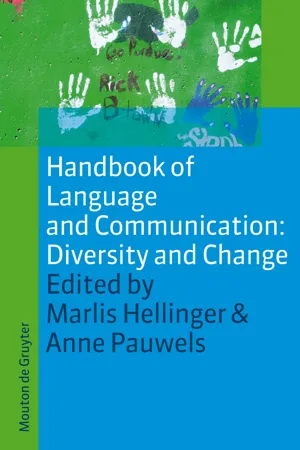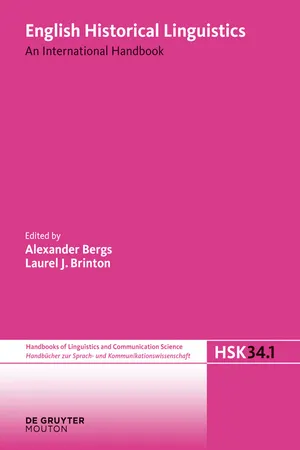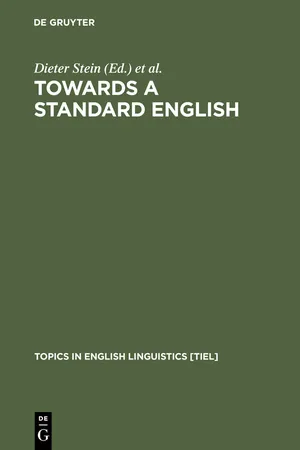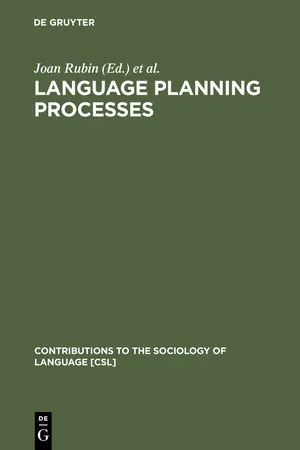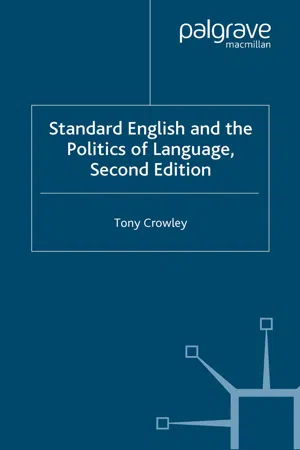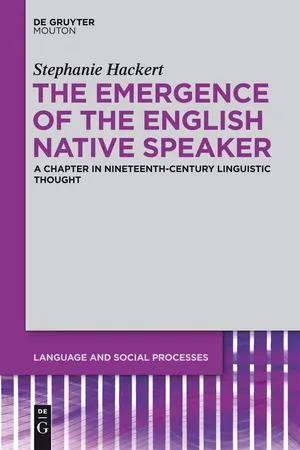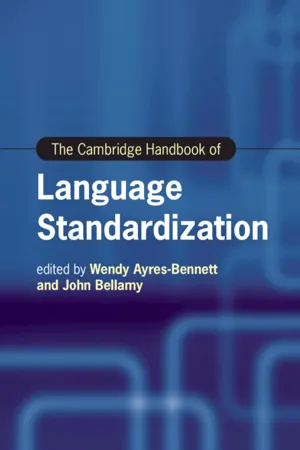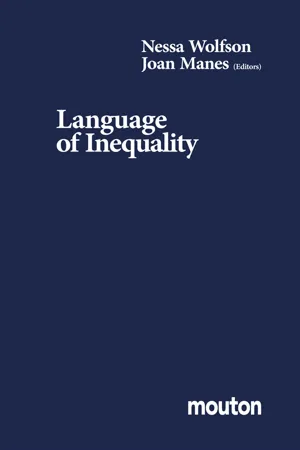Languages & Linguistics
Standardisation of English
Standardisation of English refers to the process of establishing a set of rules and conventions for the English language, including spelling, grammar, and vocabulary. This standardisation aims to promote uniformity and clarity in written and spoken communication, facilitating mutual understanding among speakers of different dialects and backgrounds. It also serves as a foundation for educational curricula and official communication.
Written by Perlego with AI-assistance
Related key terms
1 of 5
10 Key excerpts on "Standardisation of English"
- eBook - PDF
- Simon Horobin(Author)
- 2017(Publication Date)
- Red Globe Press(Publisher)
CHAPTER Standardization 3 In this chapter we will be looking at the establishment of a standard variety of English, a process known as standardization. This raises a fundamental question which we need to address at the outset: what is standard English? There are several key features of a standard language, each of which must be considered in any study of the process of standardization. The most import-ant defining feature of a standard language is its uniformity and resistance to change. Another aspect is that a standard language should be ‘suprar-egional’, that is, not tied to any particular locality and can be used by any individual irrespective of his or her geographical origins. Both factors are well-demonstrated by present-day standard English, which consists of a series of rules which enable us to determine whether a word is spelled correctly or incorrectly, whether a sentence is correctly formed or not. Another feature of a standard language is that it is used for a variety of different linguistic func-tions. Standard English is the language used by our government, legal system and educational system, all of which uses help to reinforce and sustain its continued acceptance as the standard variety of English. Its association with these various institutions also lends it prestige, so that it is the variety that people associate with social advancement. Present-day standard English has also been ‘codified’: that is, its rules have been set out in various grammar books and dictionaries so that there is a common agreement over what is acceptable and what is not. While each of these aspects is fulfilled by standard English spelling and grammar, they are less true of the standard English reference accent, known as Received Pronunciation (RP). RP is an accent that is spoken by members of a certain class rather than people from a particular geographical area. - Marlis Hellinger, Anne Pauwels, Marlis Hellinger, Anne Pauwels(Authors)
- 2008(Publication Date)
- De Gruyter Mouton(Publisher)
Despite the fact that a standard language exists primarily as an ideal notion, the changes that accompany standardization may be highly visible, as in the case of spelling reform or the publication of prescriptive grammars and diction-aries. Joseph (1987: 13) claims that “standard languages, whatever their genetic affiliation, constitute a valid category unto themselves”. This suggests that des-pite the fact that standardization may operate on quite distinct languages, we may expect to find commonalities of evolution across diverse socio-cultural and political settings in which it is carried out. Similarly, Milroy and Milroy’s (1999) notion of “standard language cultures” points to shared practices, dis-courses, beliefs and attitudes that shape and surround the enterprise of standard-ization. Language standardization and the choice of language(s) used as media of education, government, etc. are not disinterested academic exercises. Prefer-ences for particular languages and language varieties are always articulated within the context of an ideology that reflects society’s view of itself. 686 Suzanne Romaine 2. Standardization processes From a technical linguistic point of view, the process of standardization con-verts one variety into a standard by fixing and regulating its spelling, grammar, etc., in dictionaries and grammars that serve as authorities in prescriptive teach-ing to both native speakers and foreign learners. The notion of standard thus applies primarily to the written rather than spoken form of language (Milroy and Milroy 1999). Standardization and literacy go hand in hand because the acquisi-tion of literacy presupposes the existence of a codified written standard, and standardization depends on the existence of a written form of language. When a language is written, linguistic matters can be subject to regulation in a way they cannot be when a language exists in spoken form only.- eBook - PDF
- Alexander Bergs, Laurel J. Brinton, Alexander Bergs, Laurel J. Brinton(Authors)
- 2012(Publication Date)
- De Gruyter Mouton(Publisher)
Section 2 will disentangle the polysemy of the term “standard” as it has been applied throughout the history of English. We will see that in different periods, various levels of linguistic organization were prominent in undergoing standardization, and the term “standard” as established by scholars for a particular variety in a particular period therefore varies widely in its scope. Section 2.1 will deal with what has been labelled “Standard Old English” or “West Saxon (literary) standard”. Section 2.2 will focus on the trilingual communicative space in the Middle English period and the re-emergence of English vernacular writing as a precondition for further standardization. Early Mod-ern and Late Modern standardization processes and ideologies will be the topic of Sections 2.3 and 2.4, respectively. 1 . 1 Processes of standardization Being in possession of a standard is neither a necessary nor a sufficient condition for a language, if we look upon “language” as the property of a speech community with shared norms (cf. Labov 1972: 27). A standard combines the two requirements of “min-imal variation in form” and “maximal variation in function” (Haugen 1966: 931) and thus goes far beyond the notion of shared norms. In order to get a clearer understanding of the polysemous terms “language” and “norm” and their correspondences, it is help-ful to recollect Coseriu’s model of language (Coseriu 1971), as e.g. put forward by Koch (1988). 62 Standardization: Standards in the history of English 995 Coseriu distinguishes three levels of language: first, there is the universal level of language as the common property of all humans. Human linguistic activities are typ-ically realized in a particular language such as English or French (which he labels language d[escriptive] ) and, more specifically, in individual discourses. - eBook - PDF
Towards a Standard English
1600 - 1800
- Dieter Stein, Ingrid Tieken-Boon van Ostade, Dieter Stein, Ingrid Tieken-Boon van Ostade(Authors)
- 2012(Publication Date)
- De Gruyter Mouton(Publisher)
1. Notions of standard A major theoretical issue lies in the fact that it is not the case that all of the in-cipient or, to various degrees, embryonic forms of more widely used prestige 2 Dieter Stein varieties in the history of English could, by a more strict definition, be called standard languages. There seem to be three uses of the term standardiza-tion. There is an extended use which would apply to all manner of varieties, the notion of standardization with standard as the resulting variety. To this type of variety James Milroy (this volume) assigns the term supra-local language norms. These constitute localized or regional norm standards. Such varieties are instances of language convergence in various degrees and certainly carry prestige, which is largely a function of their use in various combinations of the following situations, such as are listed by Görlach (1988: 133-134): a) as a written language b) as a literary language c) as a religious language d) as a language of education and science e) as a language of the law courts, parliament and the court etc. f) as a lingua franca g) as a national language h) as a language of the mass media (newspaper, radio, television etc.). This first, wide, notion of the term standard seems to be inherent in the majority of work on at least the history of English (Görlach 1988, Trahern 1989). A second, narrow or restricted, definition of standardization was devel-oped in language planning research in countries with no nationally accepted varieties and with the problem of having a language in addition to a range of dialects. Haugen (1966) describes the following constitutive processes in creating a standard language: • selection • codification • elaboration • acceptance. Garvin (1964), based on Garvin and Mathiot (1960), gives the following defining features for a standard language: 1. the intrinsic properties of a standard language; 2. the functions of a standard language within the culture of a speech commu-nity; 3. - eBook - PDF
- Joan Rubin, Björn H. Jernudd, Jyotirindra DasGupta, Joshua A. Fishman, Charles A. Ferguson, Joan Rubin, Björn H. Jernudd, Jyotirindra DasGupta, Joshua A. Fishman, Charles A. Ferguson(Authors)
- 2013(Publication Date)
- De Gruyter Mouton(Publisher)
'Ideal standardization refers to a language which has a single, widely accepted norm which is felt to be appropriate with only minor modifica-tions or variations for all purposes for which language is used. Differences between regional variants, social levels, speaking and writing and so on, are quite small' (Ferguson 1962: 54). Labov offers a slightly different view: he sees a standard as one more style in the repertoire of a speech community. Pidgins and creóles differ from a standard language not because the concept of a particular verb tense is present or absent, but rather in the way in which the concept is expressed. The Czechs allow for 164 Joan Rubin functional differentiation of standard language norms by considering the different domains for which a language is to be used, and they isolate major domains in which standardization efforts might be of use: for example, workday, technical, scientific technical, poetic. Standardization is seen as a reiterative process affecting different domains of a language in different ways. For the Czechs, standard language seems to be one which has a complete range of expression, or at least develops processes for generating a complete range of expression. In describing the Nor-wegian setting, Haugen (1966a) says, Ά standard language today is not felt to be complete unless it has a wide range of expression for intimate, emotional life.' He is pointing to the fact that Norwegians see the need to include such varieties in their standard language. It is worth noting that in many bilingual situations the language undergoing standardization may be restricted in its functions because another language is used in the home or in poetry. The standard language may be limited to business, administration and other public sectors. Many standardized languages may not fulfill all the functions which the Norwegians seem to desire for their national language. - T. Crowley(Author)
- 2003(Publication Date)
- Palgrave Macmillan(Publisher)
Hence the theoretical and methodological problems faced by linguists when considering ‘a language’ were to be met by the concept of the ‘standard language’. In a sense we might argue that this use of the ‘standard language’ is the equivalent of Saussure’s langue in the langue–parole distinction. The Standard Language: the Literary Language 83 The standard language: the uniform language? In this sense then the ‘standard language’, used synonymously by Hermann Paul with ‘the common language’, was a sort of meta- language. It is a form of language in any particular national geographic territory which lies beyond all the variability of usage in offering unity and coherence to what otherwise appears diverse and disunited. It is the literary form of the language that is to be used and recognised all over the national territory. Historians of the language first perceived what they took to be a ‘standard’ form of the English language in this sense in the collection of texts that remained from the Old English period. Within those texts the linguists specified a group that exhibited a form of the language that was taken as the ‘standard’, the West Saxon. For example the early linguistic historian Kemble held that for the study of Old English: As, in giving any account of what in grammatical parlance we call dialects or variations, we necessarily assume a fixed standard from which to measure deflections, we shall take the West Saxon dialect as that standard. (Kemble, 1845, p.130) Interestingly, it is a ‘dialect’ that is specified here as the original form that becomes recognised as the ‘standard’ by which we can measure deviation. And later the Wrights followed this lead and asserted in their Old English Grammar that: There can hardly be any doubt that all practical teachers of the subject will agree that it is better and easier for the student to take early West-Saxon as the standard for Old English and to group around it the chief deviations of the other dialects.- eBook - PDF
Language, Nation and Power
An Introduction
- R. Millar(Author)
- 2005(Publication Date)
- Palgrave Macmillan(Publisher)
If the knowledge of a standardized form of any language remains in the hands of the language planning elite, it is unlikely that it can be treated as anything other than a complex game, a point to which we will return in Chapter 8. In the past, however, in those periods where literacy has been low, we can probably speak of a micro-standardization process within the literate elite, where one element is sufficiently powerful or influential to establish its written form as equivalent to the written form of the language as a whole. A particularly apposite example of this process can be seen in the West Saxon Schriftsprache discussed in Chapter 5. Interestingly, it is almost impossible to think of a standardization process, whether circumstantial or engineered, which has not taken place in a situation of expanding social horizons and growing potential for education and therefore literacy (at least among a potential or actual middle class), even if, as Crowley (1996) suggests, the process is often informed by fears over linguistic and social threats. The successful proto- standard form of English was established in a situation of growing urbanization, with an expanding middle class and the full-scale devel- opment of an early form of capitalism, including, in line with Anderson (1991), print capitalism as a means of ‘imagining the nation’. The fact that the standardization process was carried out by an elite in the Royal Chancery and elsewhere in the centre should not blind us to the man- ner in which it spread among non-elite members of the community. This spread was only possible due to the spread of literacy among this middle class. The imposition of the standard throughout the English- speaking world was accomplished largely through mass education, producing literacy only in this variety. - eBook - PDF
The Emergence of the English Native Speaker
A Chapter in Nineteenth-Century Linguistic Thought
- Stephanie Hackert(Author)
- 2012(Publication Date)
- De Gruyter Mouton(Publisher)
All that a teacher of pronunciation is justified in saying is, “This word is pronounced in such and such a way by good speakers.” But if he has not heard good speakers pronounce the word; if he himself is not naturally one (that is, from the time he learned to speak) […], then he simply does not know, and cannot teach the pronunciation of it. (Wyld 1969 [1906]: 362) From written to spoken standards for English 129 6.1.8 Educated English = a level of excellence which need not be homogenous in reality If standard English is no longer defined linguistically but by the group of speak-ers that uses it habitually, no efforts are necessary to demonstrate its linguistic boundaries or internal homogeneity. In fact, as will be illustrated below, to posit uniformity for the spoken standard would have been detrimental to its theorists in that they were eager to project this variety as entirely natural – as natural as the dialects. The literary language had been shown to be artificial and decayed in that its growth had been arrested by standardization, which had involved the imposition of uniformity and homogeneity. This, in the view of nineteenth-cen-tury theorists of language, was an undesirable outcome in that the most impor-tant property of language was seen to be change. Change, however, presupposed the presence of variation; if variation no longer existed, a language had lost its capacity for change, which then made it an artificial language. That the standard of spoken English, unlike its written equivalent, has less to do with uniformity and commonality than with evaluation and levels of excel-lence is already acknowledged by the nineteenth- and early twentieth-century writers. The following excerpt presents Sweet’s view of the matter. - Wendy Ayres-Bennett, John Bellamy(Authors)
- 2021(Publication Date)
- Cambridge University Press(Publisher)
This view may appear unusual, as conventional historical-linguistic narratives suggest that standardization is a process that is mostly imposed from above. It will be argued here that such narratives are a consequence of data selection driven by a standard language ideology in traditional histories of linguistic standardization. The concept of language standardization in a view from below, however, rests on the assumption that potentially all members of a language community and all of their forms of verbal interaction have con- tributed to the standardization processes of this language. 3.2.1 A Critical Review of Traditional Histories of Linguistic Standardization and Standardization Models Since the 1990s, traditional language histories and their depiction of stand- ardization have been increasingly questioned. As a result, ‘alternative lan- guage histories’ have been called for (e.g. Watts & Trudgill 2002; Elspaß 95 Language Standardization in a View ‘from Below’ 2015a). The narratives of traditional histories of language standardization have been criticized on several grounds: (1) Traditional histories of linguistic standardization are driven by a highly teleological perspective (presented in the ‘funnel model’ of standardi- zation; cf. Milroy 1992: 51–2; Watts 2011: 290–4, 2012: 585–7). (2) Traditional narratives are biased towards a succession of supposedly homogenous varieties; this has been characterized as ‘tunnel vision’ (Watts & Trudgill 2002:1) or the ‘tunnel view’ (Watts 2012: 585) of lan- guage historiography. The notion of homogenous varieties is, in turn, a consequence of the fact that the standard ideology is projected back to the past (cf. Milroy & Milroy 1991: 22–3, and Milroy 1992: 124–5 for English; Durrell 2000 for German). (3) As a result of the notion of homogenous standard languages, tradi- tional narratives tend to neglect the role of ongoing historical language variation in language standardization processes.- eBook - PDF
- Nessa Wolfson, Joan Manes(Authors)
- 2012(Publication Date)
- De Gruyter Mouton(Publisher)
Franklin C. Southworth The Social Context of Language Standardization in India In the last chapter of his book Language, Leonard Bloomfield suggests a relationship between language and social status, and implies that the acquisi-tion of the latter can be assisted by the manipulation of the former (or that this is at least a common belief): The background of our popular ideas about language is the fanciful doctrine of the eighteenth-century grammarians . . . . It is no accident that the grammarians arose when they did. During the eighteenth and nineteenth centuries our society went through great changes; many persons and families rose into relatively privileged positions and had to change from non-standard to standard speech (Bloomfield 1933: 496-7). What may not be clear from Bloomfield's discussion of this point is that the very idea of a 'standard' language—a single, uniform variety which serves as a model of usage for everyone in a society, and which everyone is supposed to be able to learn—was a very new idea at that time. Up until the mid-eighteenth century or so, such an idea would have been meaningless, since the class structure was qvite rigid, the speech habits (as well as other social customs) of different social classes were often sharply different, and there was in general no reason to expect a member of one class to learn the speech of another. The speech of each group was considered appropriate to that group and its activities: thus, for example, upper-class speech was the language of education, since only the upper classes were educated. The changes which Bloomfield discusses did not come about merely as the result of changes in the fortunes of particular families. Rather, it was the result of changes in the mode of production, as western Europe moved from a feudal to a capitalist stage, which brought greater economic—and ultimately political—power to the emerging bourgeoisie.
Index pages curate the most relevant extracts from our library of academic textbooks. They’ve been created using an in-house natural language model (NLM), each adding context and meaning to key research topics.

